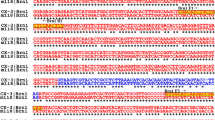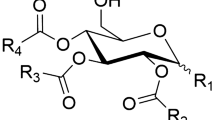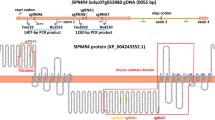Abstract
The fungal pathogen Alternaria alternata f. sp. lycopersici produces host-selective AAL-toxins that cause Alternaria stem canker in tomato. Susceptibility to the disease is based on the relative sensitivity of the host to the AAL-toxins and is controlled by the Asc locus on chromosome 3L. Chemical mutagenesis was employed to study the genetic basis of sensitivity to AAL-toxins and susceptibility to fungal infection. Following the treatment of seeds of a susceptible line with ethyl methanesulphonate (EMS), resistant M2 mutants were obtained. Most plants with induced resistances showed toxin-sensitivity responses that were comparable to those of resistant control lines carrying the Asc locus. In addition, genetic analysis of the mutagenised plants indicated that the mutations occurred at the Asc locus. Furthermore, novel mutants were identified that were insensitive to the AAL-toxins at the seedling stage but toxin-sensitive and susceptible to fungal infection at mature stages. No AAL-toxin-insensitive insertion mutants were identified following a transposon mutagenesis procedure. Molecular mechanisms involved in host defence against A a. lycopersici are discussed.
Similar content being viewed by others
References
Erickson JM, Rahire M, Rochaix J-D (1985) Herbicide resistance and cross-resistance: changes at three distinct sites in the herbicide-binding protein. Science 228:204–207
Feys BJF, Benedetti PL, Panfold CN, Turner JG (1994) Arabidopsis mutants selected for resistance to the phytotoxin coronatine are male sterile, insensitive to methyljasmonate, and resistant to a bacterial pathogen. Plant Cell 6:751–759
Freeling M, Bennett CD (1985) Maize Adh1. Annu Rev Genet 19: 297–323
Gierl A, Saedler H (1992) Plant-transposable elements and transposon tagging. Plant Mol Biol 19:39–49
Hirschberg J, McIntosh L (1983) Molecular basis of herbicide resistance in Amaranthus hybridus. Science 222:1346–1349
Johal GS, Briggs SP (1992) Reductase activity encoded by the HM1 disease resistance gene in maize. Science 258:985–987
Jones DA, Thomas CM, Hammond-Kosack KE, Balint-Kurti PJ, Jones JDG (1994) Isolation of the tomato Cf-9 gene for resistance to Cladosporium fulvum by transposon tagging. Science 266: 789–793
Jørgensen JH (1992) Discovery, characterization and exploitation of Mlo powdery mildew resistance in barley. Euphytica 63:141–152
Knapp S, Larondelle Y, Rossberg M, Furtek D, Theres K (1994) Transgenic tomato lines containing Ds elements at defined genomic positions as tools for targeted transposon tagging. Mol Gen Genet 243:666–673
Lassner MW, Palys JM, Yoder JI (1989) Genetic transactivation of Dissociation elements in transgenic tomato. Mol Gen Genet 218:25–32
Lee KY, Townsend J, Tepperman J, Black M, Chui CF, Mazur B, Dansmuir P, Bedbrook J (1988) The molecular basis of sulfonylurea herbicide resistance in tobacco. EMBO J 7:1241–1248
Matzke M, Matzke AJM (1993) Genomic imprinting in plants: Parental effects and trans-inactivation phenomena. Annu Rev Plant Physiol Plant Mol Biol 44:53–76
Mazur BJ, Falco SC (1989) The development of herbicide resistant crops. Annu Rev Plant Physiol Plant Mol Biol 40:441–470
Meeley RB, Johal GS, Briggs SP, Walton JD (1992) A biochemical phenotype for a resistance gene of maize. Plant Cell 4:71–77
Merrill AH, Wang E, Gilchrist D, Riley R (1993) Fumonisins and other inhibitors of de novo sphingolipid biosynthesis. Adv Lipid Res 26:215–234
Stam P (1993) Construction of integrated genetic linkage maps by means of a new computer package: JOINMAP. Plant J 3:739–744
Van den Bulk RW (1991) Application of cell and tissue culture and in vitro selection for disease resistance —a review. Euphytica 56:269–285
Van der Biezen EA, Glagotskaya T, Van der Luit A, Overduin B, Nijkamp HJJ, Hille J (1993) Characterization of sensitivity to Alternaria alternata f. sp. lycopersici toxins. In: Kohmoto K, Yoder OC (eds) Host-specific toxin: biosynthesis receptor and molecular biology. Tottori, Japan, pp 300–301
Van der Biezen EA, Overduin B, Kneppers TJA, Mesbah LM, Nijkamp HJJ, Hille J (1994a) Molecular genetic characterisation of the Asc locus of tomato conferring resistance to the fungal pathogen Alternaria alternata f. sp. lycopersici. Euphytica 79:205–217
Van der Biezen EA, Overduin B, Nijkamp HJJ, Hille J (1994b) Integrated genetic map of chromosome 3 of tomato. Tomato Genet Coop Rep 44:8–10
Van der Biezen EA, Van Haaren MJJ, Overduin B, Nijkamp HJJ, Hille J (1994c) Heterologous transposon tagging as a tool for the isolation of plant genes. In: Gelvin SB, Schilperoort RA (eds) Plant molecular biology manual. Kluwer, Dordrecht, K2:1–16
Van der Biezen EA, Glagotskaya T, Overduin B, Nijkamp HJJ, Hille J (1995) Inheritance and genetic mapping of resistance to Alternaria alternata f. sp. lycopersici from Lycopersicon pennellii. Mol Gen Genet 247:453–461
Vogel EW, Nivard MJM (1994) The subtlety of alkylating agents in reactions with biological macromolecules. Mutation Res 305: 13–32
Walton JD, Panaccione DG (1993) Host-selective toxins and disease specificity: perspectives and progress. Annu Rev Phytopathol 31:275–303
Yadav N, McDevitt RE, Benard S, Falco SC (1986) Single amino acid substitutions in the enzyme acetolactate synthase confer resistance to the herbicide sulfomethyl. Proc Natl Acad Sci USA 83:4418–4422
Yoder OC (1980) Toxins in pathogenesis. Annu Rev Phytopathol 18:103–129
Author information
Authors and Affiliations
Additional information
Communicated by M. Koornneef
Rights and permissions
About this article
Cite this article
van der Biezen, E.A., Nijkamp, H.J.J. & Hille, J. Mutations at the Asc locus of tomato confer resistance to the fungal pathogen Alternaria alternata f. sp. lycopersici . Theoret. Appl. Genetics 92, 898–904 (1996). https://doi.org/10.1007/BF00221904
Received:
Accepted:
Issue Date:
DOI: https://doi.org/10.1007/BF00221904




